A Useful Frequency Chart r/edmproduction
For this reason, if analyzing music with a frequency chart - known as a frequency spectrum - it's possible to identify which instruments contribute most to different frequency ranges. As humans, we can only hear sound vibrations between 20 Hz and 20,000 Hz, but that's enough to contain all of the different sounds in the most common music forms.

All About EQ Part 2 Aviom Blog
Understanding the Different Frequency Ranges. For most people, the audible hearing spectrum ranges from about 20 Hz to 20 kHz. That's roughly 20,000 different frequencies to deal with in any given track—from the deepest kick drum the brightest cymbals and strings. Thankfully, by breaking the full frequency spectrum into smaller frequency.
Helpful Frequency Chart r/WeAreTheMusicMakers
Snares and air: 8 kHz and above. To shape the sound of a snare drum, start by boosting the fundamental around 150-250 Hz. This can add weight and thickness to the sound, though it can also conflict with the vocal. For a brighter and more cutting snare, a boost in the range of 2-3.5 kHz can enhance the snap and attack.

An easy guide to reading your audiogram with pictures and illustrations
Rolling off an element's bottom end will push it forward in the mix. Rolling off the top end will push it back. EQ for size when dealing with fewer instruments in a mix. When mixing a 4- or 5-piece rock band, for instance, every instrument should sound quite large. In a dense mix with many instruments, each one should sound much smaller.

Musical Instrument Sound Chart, August 1967 Electronics World RF Cafe
An EQ cheat sheet, also called an audio frequency chart or instrument frequency chart, isn't a list of rules that you must follow; it is a guide that provides starting points and general ideas for your mixes with sounds, instruments, and vocals. It's a graphical representation that shows you frequency responses of common instruments across.
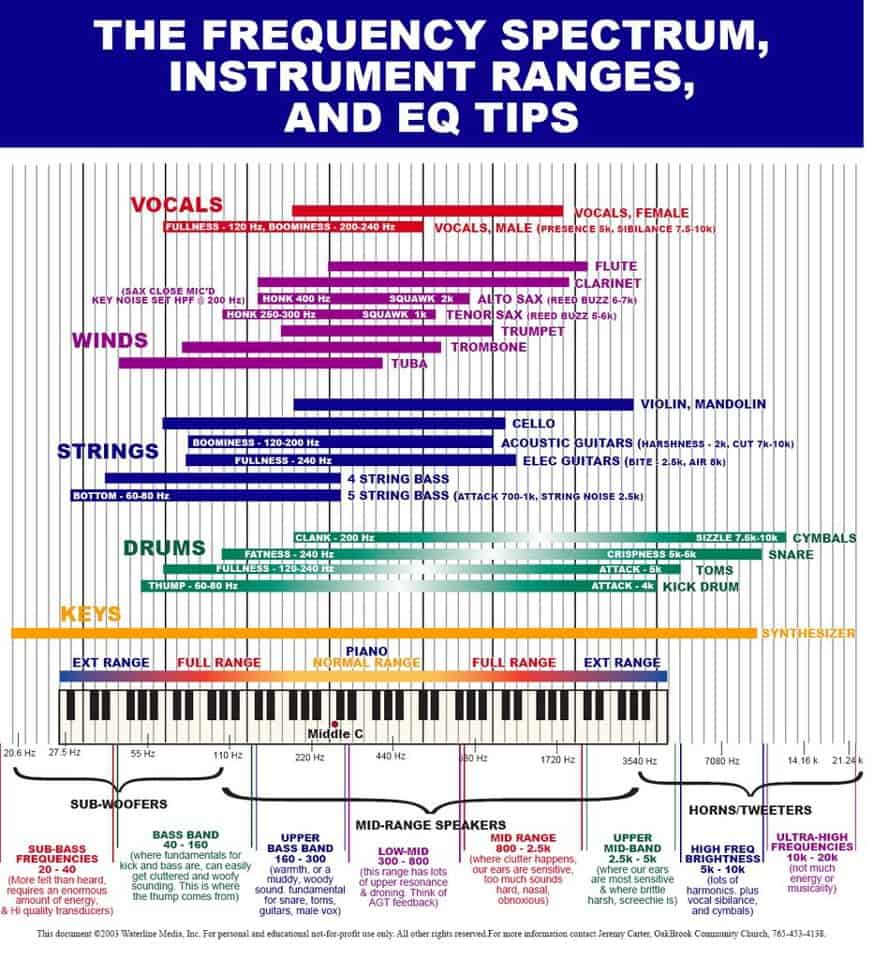
The Frequency Spectrum, Instrument Ranges And EQ Tips Music Crowns
The first step to knowing how to EQ is understanding where all your instruments fit on the frequency spectrum. That's why we created this EQ cheat sheet for all your EQing needs. Seeing where each instrument fits on the frequency spectrum will help you identify which instruments and frequencies might be fighting each other in your mix, and.
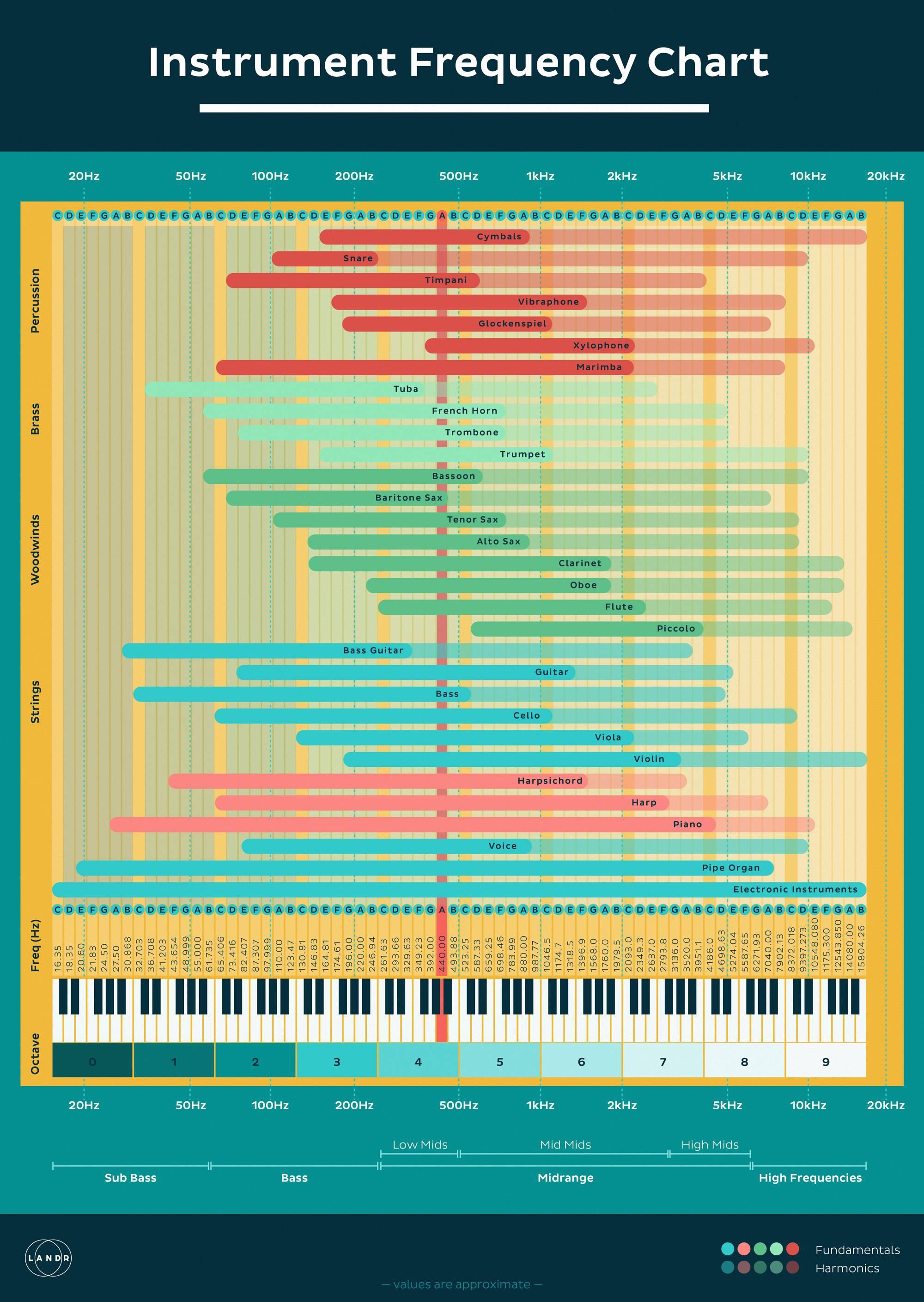
Visual Instrument Frequency Chart Infographic.tv Number one
Some guideline: below 40 Hz: sub-bass. 40-80 Hz: bass. 80-200-400-800 Hz: low-middle-center mids. This is probably the most active region, this is where most melody notes (both vocal and instrumental) will fit, as well most of the harmonic/rhythmic instruments. You may want to divide this into several bands.

Helpful Frequency Chart WeAreTheMusicMakers Music chords, Music
The instrument frequency chart is a visual representation of these profiles 一 guiding producers and sound engineers in their mixing decisions. For instance, when looking to layer a violin over a piano in a hip-hop track, you might consult the chart to ensure there's minimal frequency clashing.

How to Play Bass with a Drummer (Foolproof Beginner Blueprint
Many instruments struggle to enter this frequency range, with the exception of a few bass-heavy instruments, such as the bass guitar which has the lowest achievable pitch of 41 Hz.. Summary Table. Frequency Range Frequency Values; Sub-bass: 20 to 60 Hz: Bass: 60 to 250 Hz: Low midrange: 250 to 500 Hz: Midrange: 500 Hz to 2 kHz: Upper.

SINE Musical Instrument Frequency Chart
Frequency Ranges So you probably noticed that one of the common trends in all the categories of instruments was that size has big effect on the sound quality of instruments.. Check out the following chart and see where your instrument falls in the spectrum of high to low! For the purposes of this, Just refer to the black sections of the each.
The Frequency Spectrum, Instrument Ranges, And EQ Tips dataisbeautiful
The first step to understanding how to EQ is knowing where your recordings sit in the frequency scale. This is why I have made this EQ cheat sheet for your EQ referencing. Visualizing where each instrument sits in the frequency scale will help you determine which frequencies and sounds are clashing with each other in your mix, and will help you.
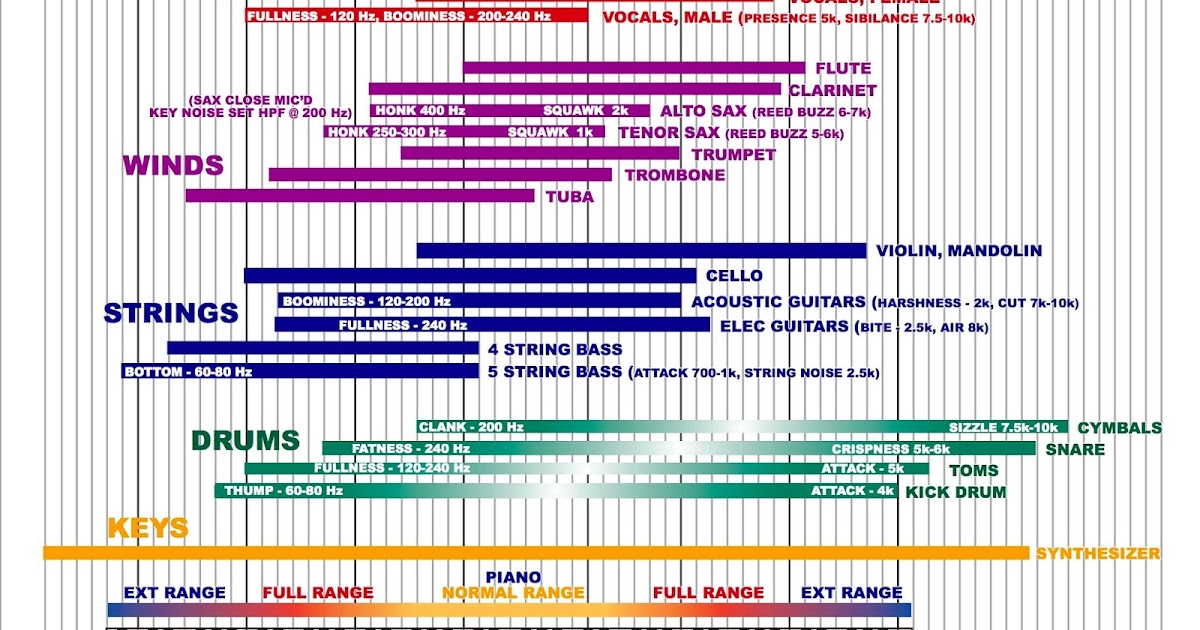
JE Labs Reality Check Musical Instrument Frequency Chart + A Tidbit
Interactive Frequency Chart. [ April 3, 2017 ] Pictured below is what looks to me like a very handy chart of the frequency range of orchestral instruments. This is intentionally small because you should click the image to be taken to the interactive version of the chart. Frequency Chart. During the mixing phase, it's common practice to use.
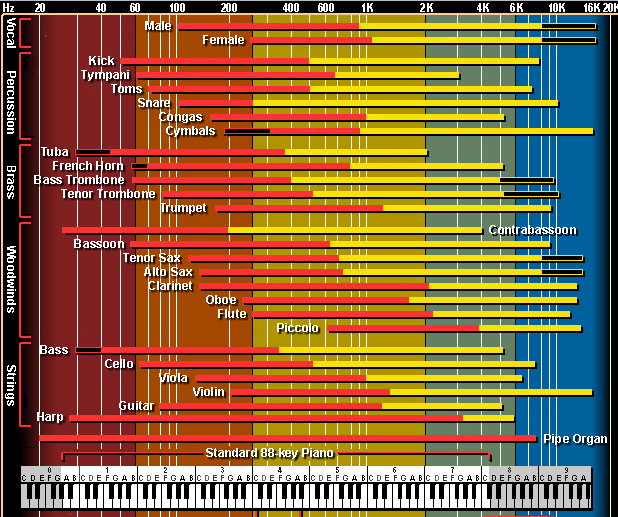
Interactive Frequency Map OSIRIS GUITAR
EQ Frequency Chart. To make it easier to create a balanced frequency chart music, it also helps to have a summary of the EQ recommendations for each instrument. Use this handy EQ chart that follows: 50 Hz. Increase for drums to add fullness; decrease for bass to reduce boom and make overtones clearer.

Frequencies Of Musical Instruments Musical Instruments Frequency
THE FREQUENCY SPECTRUM, INSTRUMENT RANGES, AND EQ TIPS HONK 250-300 Hz SQUAWK 1k HONK 400 Hz SQUAWK 2k TENOR SAX (REED BUZZ 5-6k) (SAX CLOSE MIC'D KEY NOISE SET HPF @ 200 Hz) This document ©2003 Waterline Media, Inc. For personal and educational not-for-profit use only.
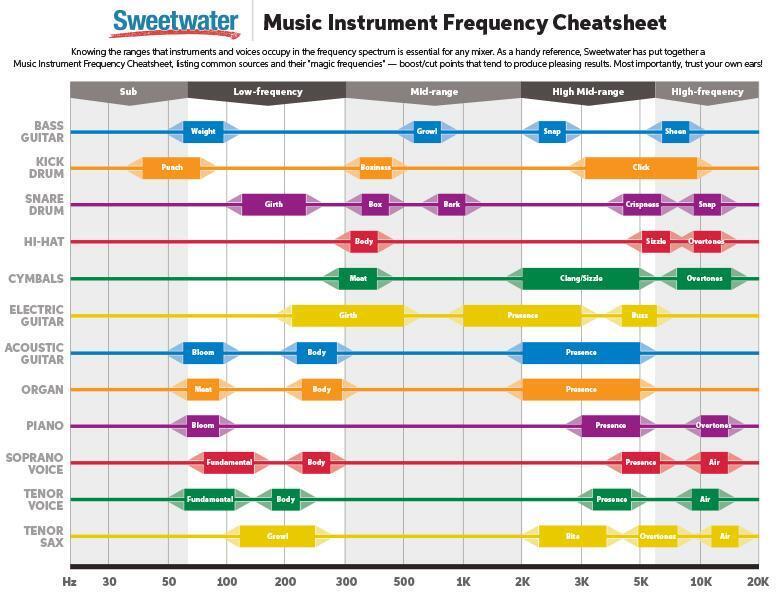
Good book for general frequency ranges
Having the instrument frequency chart in front of you can be very handy when trying to think about which instrument fits where. That said, all instruments are unique- the timbre, tone, and even frequencies produced can vary depending on the context. Trying to use a violin for a fast piece with super high harmonics is a terrible idea as getting.
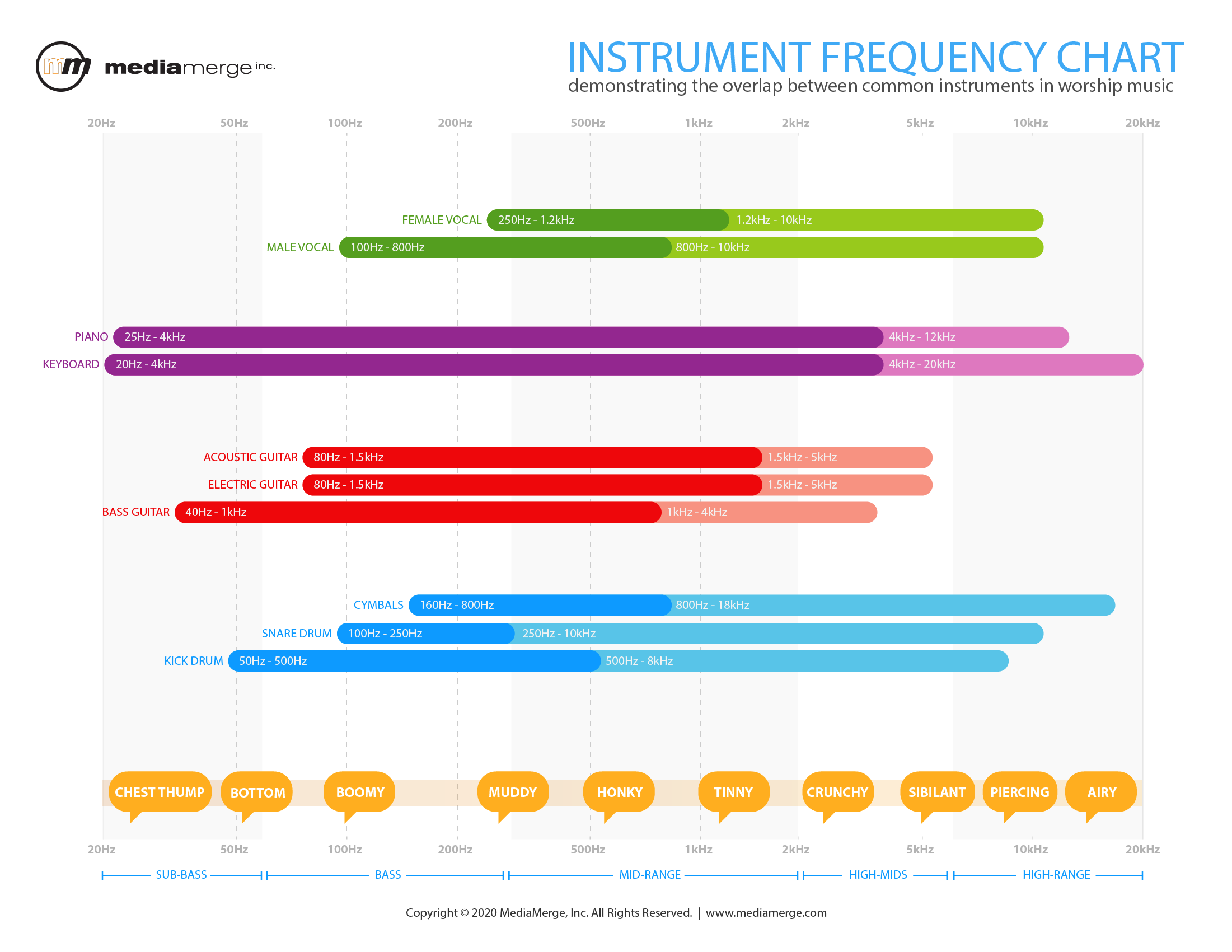
Download the FREE Instrument Frequency Chart for Church Sound Techs
An EQ cheat sheet, also called an instrument frequency chart or an audio frequency chart, is an infographic that displays the supposed frequency responses of every common instrument laid out across the frequency range of human hearing. They also provide tips regarding fundamental and harmonic frequencies, subjective sounds like 'squeek' and.